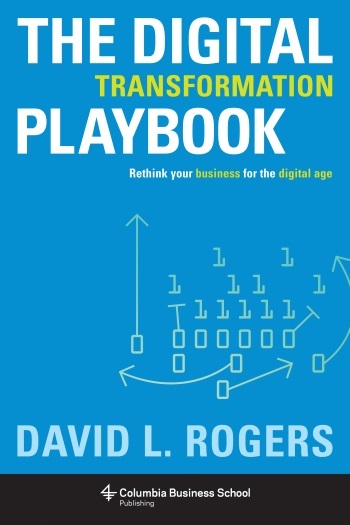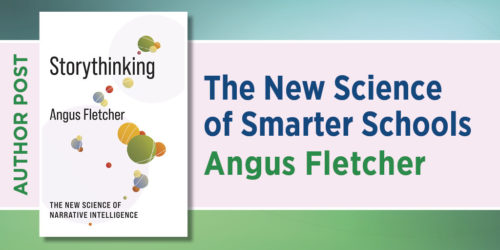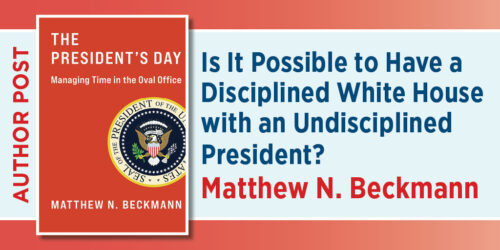Lessons from Google and Columbia’s CMO Academy
“As the media available to customers proliferates, effective targeting is absolutely critical. Your message matters; but increasingly, who you reach is the difference between success and failure. In the digital era, targeting is fundamentally different than the traditional world of media buying. Marketers must shift from the old thinking of audiences (based on demographic fictions, e.g. ‘fashion-savvy, 25-40 year old, urban mothers’) towards addressing specific customers based on their actual behaviors.” — David L. Rogers
This week, our featured book is The Digital Transformation Playbook: Rethink Your Business for the Digital Age, by David L. Rogers. In today’s post, crossposted from David Rogers’s blog, Rogers details seven important lessons learned from Google/Columbia Business School’s recent “CMO Academy.”
Don’t forget to enter our book giveaway for a chance to win a free copy!
Lessons from Google and Columbia’s CMO Academy
David L. Rogers
What are the challenges that today’s Chief Marketing Officers face as they manage a changing role and rising expectations in a world shaped by digital technologies? I got to discuss this question with a hundred CMOs of North American companies recently, while teaching a joint Google/Columbia Business School program, our first-ever “CMO Academy.” The invited executives from the US, Canada, and Mexico represented a diverse range of industries from fashion to financial services, and hospitality to healthcare.
Below are seven lessons that emerged through two days of case studies, interactive presentations, and hands-on problem solving with this group.

1. The Funnel Has Changed
The use of the marketing funnel as a strategic tool is undiminished, with various demands across the funnel. At the top of the funnel, 85% of our CMOs were focused on driving brand awareness and 51% on lead generation. At the same time, these CMOs need to deliver sales, both offline (59%) and online (49%). Beyond the point of sale, 73% of the CMOs said that customer loyalty was a critical objective for them.
The funnel is changing, though, as customer behaviors are transformed by digital habits and experiences. Traditional marketing tools–such as television, radio, and out-of-home advertising–are still important, but not always efficient or effective to reach the right audience. At the same time, the interactions of customer networks are shaping each stage of the funnel. (see my article on “rethinking the marketing funnel”). Search results, particularly on mobile devices, are critical in influencing awareness and consideration. Customer reviews and social media conversations are shaping brand preference. And the moment of purchase is happening across mobile, desktop, and in-person. Most importantly, marketers are thinking beyond loyalty to driving advocacy by their most engaged customers who can influence others. To achieve all their objectives, marketers need to focus on distinct digital strategies for customers who are at different stages of their funnel.
2. Content Is King
One of the top challenges identified by attendees was generating effective content. Marketers know they need to create new forms of content to engage their customers, but they are still struggling to find the right approach. We examined a variety of case studies to illustrate why not all effective content is the same. Although some content is based around storytelling (see Corning’s “Day Mad of Glass” below), other content is focused on providing utilitarian answers to a customer in a moment of need (see Home Depot’s videos for do-it-yourself home owners). Marketing content may seek to serve a broad audience, or an extremely narrow niche. Once it is created, this content may be distributed through established media publishers, or brands may choose to build their own publishing platforms.
Storytelling content by Corning
Utilitarian content by Home Depot
Google talks about a marketer’s content portfolio in three categories: “Hero” content seeks to connect with new audiences through impactful storytelling. “Help” content answers the questions of potential customers who are searching online for solutions. “Hub” content engages existing customers, by giving them a reason to subscribe and hear more from you.
3. Targeting Wins
Another common challenge voiced by CMOs was how to effectively target the right customers for their business. As the media available to customers proliferates, effective targeting is absolutely critical. Your message matters; but increasingly, who you reach is the difference between success and failure. In the digital era, targeting is fundamentally different than the traditional world of media buying. Marketers must shift from the old thinking of audiences (based on demographic fictions, e.g. “fashion-savvy, 25-40 year old, urban mothers”) towards addressing specific customers based on their actual behaviors. Netflix has shifted from making recommendations based on reported behavior (the movies you say you like) to observed behavior (what Netflix sees you actually stream at 11:00pm on Wednesdays). In the same spirit, marketers can target most effectively by using real-time data on customers’ actual viewing, searching, browsing, and purchasing behavior.
4. Measurement Is Not ROI
The biggest single concern voiced by our CMOs was how to “measure our digital campaigns and know which ones give us the best ROI.” These are actually two different goals, and it is important to not confuse the two. Marketers do need to win the support of the CFO and the CEO, and that requires being able to demonstrate how marketing delivers ROI to the firm by shaping customer lifetime value (through levers such as customer acquisition, retention, annual spend, and share of wallet). But it is equally important to recognize that not every marketing tactic can be measured through to a financial impact with equal certainty. Executives know that television advertising is not measured the same way as direct mail. Although digital tools come with a panoply of data and metrics, the tools which operate at the top of the funnel (shaping awareness, brand perceptions, and lead generation) will not be measured the same way as tools that drive directly to a point of sale. Sometimes the best route for measuring ROI of a new marketing tactic is through cost efficiency: Can I achieve my traditional marketing goal (e.g. GRPs or awareness) at a lower cost?
5. You Don’t Know What You Don’t Test
Even with metrics in place, CMOs often face challenges around attribution: how do I know which of my various marketing activities influenced the sale? Digital technologies afford marketers many more opportunities to measure as they go, and to adjust and optimize their marketing based on real customer feedback. To get the most out of any campaign, marketers must plan to test before, during, and after—that is, to plan to learn. Effective marketers use data to optimize their efforts on channel (which media are you using), on audience (who are you targeting), and on content (which messages are you using). One powerful example: with TrueView, marketers are able to place video advertisements on YouTube that customers can skip after 5 seconds (at no cost to the advertiser). Who wouldn’t want the option to test their advertising content with real customers, see which messages are actually relevant to them?
6. Talent Matters
In order to lead an effective digital marketing organization, CMOs need the right talent on their team. Most CMOs are finding they need to hire, train, and attract new skills in a variety of areas. These include: social media management (engagement and community building), content (from creation and editorial planning to distribution and SEO), digital advertising (search, display, paid social), as well as data and analytics (to measure, target, and deliver insights). Marketing departments today need a much broader array of skills than just creative planning and media buying. In addition to cultivating the right talent in their own departments, CMOs realize they need to work more collaboratively with other parts of their organization—sales, customer service, public relations, product development—in order to drive value and ensure the right experience at each stage of the customer relationship.
7. Learning Never Stops
The last challenge identified by our CMOs was the speed at which digital marketing is evolving and the increasing number of choices that it offers to marketers. I pushed the participants to resist chasing trends and planning their investments based on tools (“What’s our Snapchat strategy? What’s our Twitter strategy?”). Instead, effective leaders build strategies from clearly defined objectives and deep knowledge of their customers and their brands. With that in place, the right strategy can be chosen to draw on the best tools available. But it does require that the marketing team be a true learning organization, constantly absorbing new best practices and discovering the state of the art in its field. This is why I am such an evangelist for executive learning, both in my open programs held at Columbia Business School in New York, and for individual companies around the world. To lead in any market, learning must be continuous.
You can read this and other great posts at David L. Rogers’ website.





